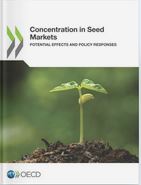 Topics Topics |
|
|
|
 Species Species |
|
|
|
|
|
Forage crops important to state agriculture, third in total earnings
New Mexico, USA
October 26, 2015

New Mexico State University conducts forage crop research at its Agricultural Science Center at Los Lunas and Tucumcari. Forage crops are ranked third in the state’s agriculture crop categories. (NMSU photo)
In New Mexico, as well as the entire country, raising forage is an important part of the agricultural industry. Forages comprise the greatest amount of crop acres in the state, and the overall crop value is second to none. Without forage, the $3.16 billion beef cattle and cow milk industry could not feed its animals.
Of all the forages grown in New Mexico, alfalfa is by far the most economically important, comprising more than 220,000 acres, worth more than $280 million.
New Mexico State University’s College of Agricultural, Consumer and Environmental Sciences’ forage team strives to help farmers meet the state’s forage needs. The team consists of Cooperative Extension Service specialists and agricultural research faculty.
Besides conducting research, the team presents the latest research-based information at conferences and workshops.
During the first-ever National Forage Week, June 21-27, promoted by the American Forage & Grassland Council, Mark Marsalis, NMSU Extension forage specialist, reflected on the importance of forage and the work NMSU is doing.
“The impact of forage goes well beyond the direct value of the marketed product. The ripple effect of a hay, pasture or silage feed is far-reaching and impacts our daily lives in many different ways that many people may not realize,” Marsalis said.
“Forages contribute a significant amount to New Mexico’s economy through support industry job creation; beef, dairy and wool operations; horse, goat and alpaca industries; and even honey production; in addition to providing environmental benefits such as soil protection and improvement of wildlife habitat.”
Forage crops in New Mexico include alfalfa and other hay, wheat for pasture, and corn, sorghum and small grain silages. These crops are not only grown as stored feeds, they also are used for livestock pastures that are frequently visited by big game, migratory birds and other wildlife.
“Hay acreage remains fairly constant from one year to the next in the state, and the value of New Mexico’s hay per ton is usually higher than the national average,” Marsalis said. “We have the perfect climate in New Mexico to grow excellent, high-quality hay – that is, as long as we have irrigation to do so.”
However, dwindling irrigation supplies and recent droughts have severely hindered the producers’ ability to grow alfalfa and other forage crops. It is this urgency of water shortage and future sustainability that drives much of the research conducted by NMSU’s forage team.
The research being conducted at NMSU’s facilities includes a wide array of projects that focus on forage species that are either currently raised in the state, such as alfalfa, or alternative species that show promise or are underutilized.
“One such species being investigated is perennial cereal rye,” Marsalis said. “This crop, which was developed in Canada, is very similar to the traditionally grown annual cereal rye without the annual input costs and soil disturbance associated with other small grains, such as wheat. It can persist for three or more years and may provide a short-lived perennial pasture for grazing operations.”
It may also have higher forage quality than many of the perennial species used currently for pasture.
“It is uncertain if it will persist under New Mexico’s growing conditions, so it is being studied at both NMSU’s Agricultural Science Centers at Los Lunas and Tucumcari for persistence and growth characteristics,” he said.
Other non-traditional forages are being studied for potential utilization in the challenging environment of New Mexico. These include teff, guar, canola and forage kochia.
“It is important to consider other crops to see if they have a fit in the different forage-based systems throughout New Mexico,” Marsalis said. “It is especially critical to identify those species that may be a better fit in severely water-limited conditions or those that diversify an operation to provide greater drought mitigation and economic stability.”
NMSU is also doing several research projects that focus on New Mexico’s number one cash crop, alfalfa. These include alfalfa planting-date and irrigation-timing studies, insect and weed pest control, and variety performance trials at several of the science centers. Other forage variety performance tests are conducted on corn, sorghum and small grain silage crops.
More news from: New Mexico State University
Website: http://www.nmsu.edu Published: October 26, 2015 |
|
|
|
Better Food Venture's
AgTech Landscape 2019

|
| |
|
2019 THRIVE Top 50
landscape map

|
| |
|
Concentration in Seed Markets - Potential Effects and Policy Responses

(OECD December 2018)
|
|
Visualizing Consolidation
in the Global Seed Industry
1996–2018

Seed Industry Structure
1996-2018
Phil Howard
Associate Professor
Michigan State University
|
|
2017 Seed Company Family Tree
Ccreated Septebmer 2017
by Robert Walsh
WaSoo Farm, Elk Point, South Dakota |
 |
Syngenta Brands Family Tree
Ccreated January 2017 by Robert Walsh, WaSoo Farm, Elk Point, South Dakota
|
 |
| |
Rabobank's
World Vegetable Map 2018 |
 |
|
|